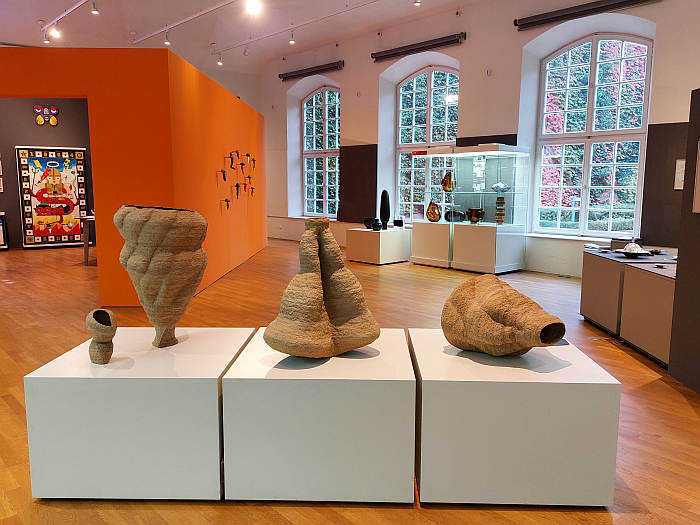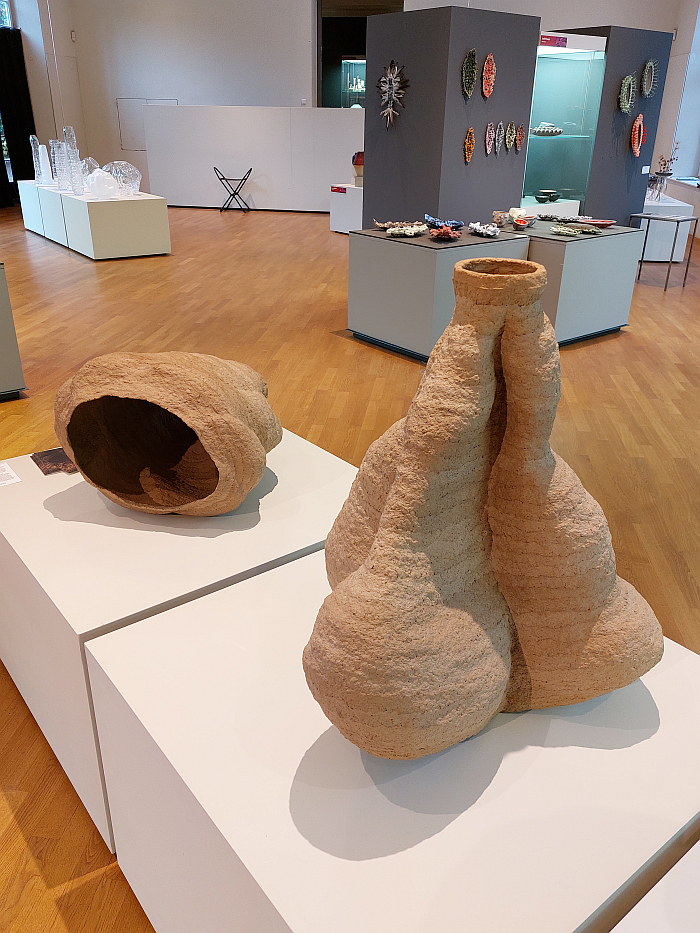Grassimesse 2023 Compact: Adobe by Ralf Stauss / Papier Langackerhäusl

Adobe by Ralf Stauss / Papier Langackerhäusl, as seen at Grassimesse 2023, Museum für Angewandte Kunst, Leipzig
As previously noted in these dispatches, in the 18th century serious attempts were made to employ Papier-mâché as a material for furniture construction, primarily in context of the so-called ‘japanning’ of the period: a fashion, a t****, in 18th and 19th century Europe for ‘Oriental’ lacquered goods that saw European craftsfolk develop their own local alternatives, not least as a response to the scarcity of the highly prized Japanese lacquered work during the Sakoku period of Japanese self-isolation. Hence ‘japanning’. And a ‘japanning’ for which Papier-mâché proved to be a particularly good material.
A use of Papier-mâché that for all it relatively quickly vanished, it was after all closely associated with a fashion, a t****, ¯\_(ツ)_/¯ , has lost nothing in its appeal. In its very loud, why not?
A question reinforced and amplified by the Adobe objects by Ralf Stauss from Kollerschlag, Austria, based Papier Langackerhäusl.
Adobe objects whose name has nothing to do with photo altering, falsifying, software, or even with portable document formats, but with the traditional mud bricks/mud construction particularly popularly associated with Central America, a construction process also employed by a great many insects; and thus a name reflective of the very obvious formal associations between Stauss’s objects and the nests and other structures built by insects from the mud and natural material they find lying around. And by the less obvious but just as present constructional associations: as with insect architecture the objects of the Adobe collection are constructed layer for layer for layer for layer, albeit from a recycled paper pulp rather than a mix of mud, leaves and spittle.
And for all the instantaneous, and very satisfying, decorative, aesthetic, visual character of the works, a character that is the sum of concept, material and process, an inherent expression of all that the objects embody, and which one can’t help but engage with, they can also be functional, can also serve as tables and stools. No, we didn’t sit on one, but have seen photos of them as side tables and bedside tables, and see no reason to doubt that, suitably statically formed, stools are also possible. And arguably also larger functional objects. Objects whose honesty, associations with nature and disruption of that famed, and limiting, quadratic geometry of our interiors will make them, we’d imagine, very easy co-habitees.
Yet beyond the value of the individual objects as objects in their own right, Adobe poses the question why not Papier-mâché for furniture and interior objects? And poses it very loudly. For all that a paperless world is desirable, it’s not something we’re going to achieve anytime soon, it’s going to take time; and simply using old paper to produce more paper can’t be an answer, can’t get us away from paper, so why not explore and develop other uses for old paper that serve other demands. Aesthetic demands and functional demands. Ideally in the one object.
Thoughts that also lead one to materials such as Newspaperwood by Studio Mieke Meijer, a material that, as its name tends to imply is a “wood” crafted from old newspapers; and a material that is very much the industrial juxtapose to Ralf Stauss’s craft process. A juxtapose that is important in its helping elucidate there are differing possibilities going forward. Differing responses. And also helping elucidate that craft and industry needn’t be in conflict, they can cooperate, can unite to explain why the 18th century Papier-mâché pioneers weren’t wrong, but couldn’t develop in the 18th and 19th centuries the arguments to justify their approach. That was going to take time. And a separation from fashion and t****s. And a rejection of applied ornamentation. And a rediscovery of honesty in materials. And insect architecture.
¿Papier-mâché furniture as another example of a New Normal that’s been around for a while but needed technical and conceptual evolutions before it could establish itself? Certainly worth contemplating as you lose yourself in the flowing, fluid geometry of an Adobe object.
Further information on Adobe, Papier Langackerhäusl and Ralf Stauss can be found at www.langackerhaeusl.at
And for all in or near Leipzig Adobe by Ralf Stauss / Papier Langackerhäusl can be experienced at the Grassimesse, at the GRASSI Museum für Angewandte Kunst, Johannisplatz 5-11, 04103 Leipzig until Sunday 22nd October
Full details of the 2023 Grassimesse, including opening hours and ticket prices, can be found at www.grassimesse.de
Tagged with: Adobe, Austria, Grassi Museum für Angewandte Kunst, Grassimesse, Kollerschlag, Leipzig, Papier Langackerhäusl, Papier-mâché, Ralf Stauss
